How To Resupply on the John Muir Trail
A detailed how-to guide for planning your JMT resupply strategy including John Muir Trail resupply points, shipping info, and mileage charts.
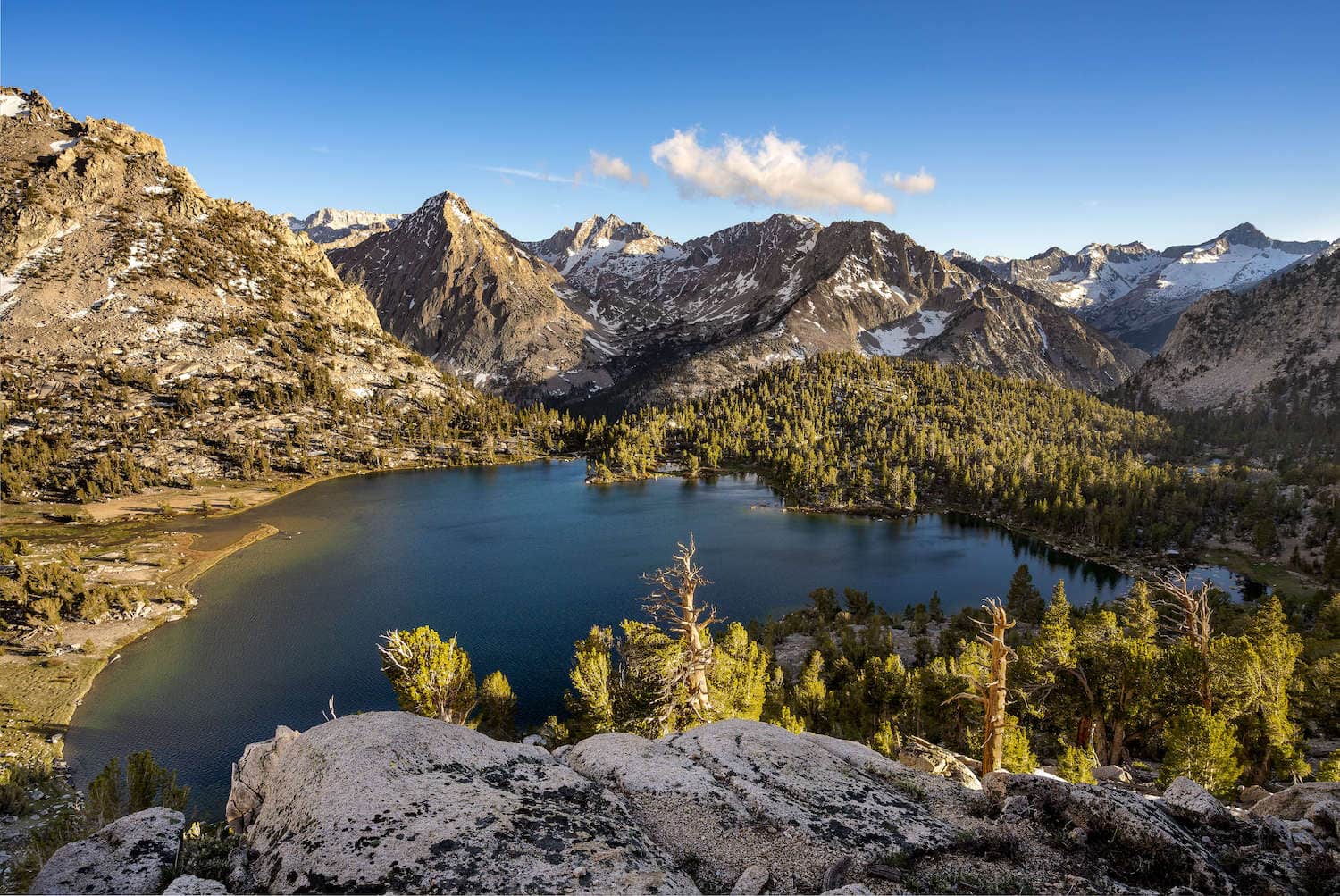
The John Muir Trail is truly a backcountry wilderness experience, where you can go weeks without reaching a road, let alone a grocery store. Planning out all your meals and arranging for resupply shipments can be one of the most daunting parts of preparing for a thru-hike but there are a few tips and tricks to breaking down 20-plus days of food into more manageable loads.
When BFT Founder Kristen hiked the JMT Southbound back in 2014, she resupplied three times: first at Red’s Meadow, then at Muir Trail Ranch, and finally at Onion Valley. In 2020, BFT contributor Mary hiked the JMT Northbound and she resupplied in the same three locations (in reverse), plus an unexpected side trip to Vermilion Valley Resort, which is also a resupply stop.
Caching food to pick up later is illegal on the JMT, so in this blog post, we walk you through how to plan your John Muir Trail resupply strategy and include information for all JMT resupply points, plus a few resources for hired resupply services.
This blog post was originally written by BFT Founder, Kristen, who hiked the John Muir Trail Southbound in 2014. It was updated in 2022 by Mary Caperton Morton of The Blonde Coyote who hiked the John Muir Trail Northbound in 2020. It includes the most recently available information.
This post may contain affiliate links.
How To Plan Your John Muir Trail Resupply in 4 Easy Steps
Step 1: Determine the total number of days you will spend on the John Muir Trail
The total John Muir Trail trail is 221 miles if you don’t take any side trips. Kristen ended up hiking about 240 miles, which included several side trips and her hike out to Onion Valley for a final resupply. Below is a breakdown of the average number of miles you need to cover each day depending on the total number of days you will be on the trail:
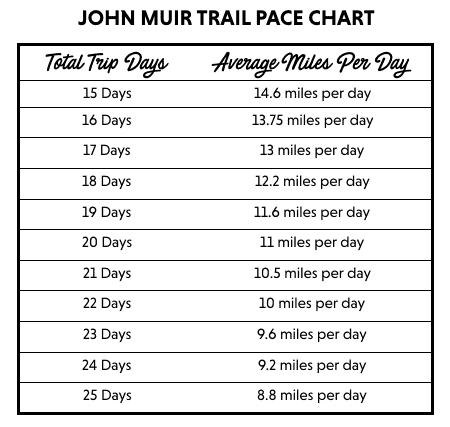
Some days you will undoubtedly go further than the average, while other days you will go less depending on the elevation gain. But you need to have a ballpark figure so you can determine how many days it’s going to take you to cover the distance between each John Muir Trail resupply point.
Step 2: Plan your menu and do your food shopping (in bulk)
What you eat on the trail is very personal. Knowing how to pack “X” number of days of compact, nutritious, delicious, and energizing calories neatly into a bear canister is one of the most important skill sets to develop as a backpacker. On the JMT, you’ll burn about double the number of calories that you might burn in a typical day at home, but you also need to balance wanting to bring lots of extra food with having to carry it all on your back and fitting it all in a bear canister.
For each day on the JMT, you’ll want one breakfast, one lunch, and one dinner, plus a few snacks, which typically averages to about 2 lbs of food per person per day. We typically had a snack in between each meal and sometimes a little post-dinner treat. I would suggest buying more than you think you will need. You will be burning a ton of calories and will be hungrier than you normally are. Read labels as you shop and select foods that are denser in calories per serving – don’t go for anything low cal or low fat. You want the most number of calories and nutrients in the smallest and lightest package to maximize the value of each food item.
When shopping for the JMT, buy more than you will think you need and plan to repackage everything into ziplocks, including store-bought backpacking meals. It’s cleaner and more efficient to cook in a light pot with an insulated cozy for rehydrating, rather than the packaging that dehydrated meals come in, as the packaging is bulky and starts to stink after a few days.
Some of the resupply points along the JMT offer hiker boxes, where fellow backpackers can donate unwanted food (usually oatmeal) and take food as needed. Red’s Meadow and Vermillion Valley Resort typically have hiker boxes, but Muir Trail Ranch does not. However, don’t bank on these boxes. Pickings are usually slim, unless you really love mystery oatmeal and crumbled, stale bars.
For more specific meal options, check out my JMT food shopping list or these simple backpacking food ideas.
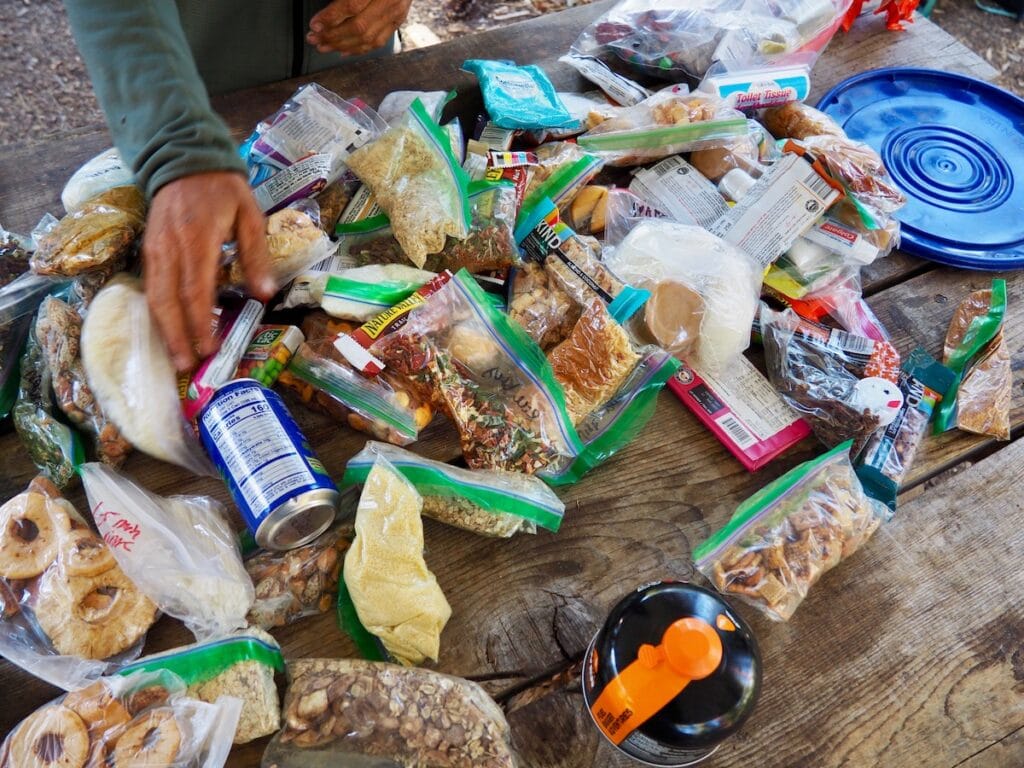
Step 3: Sort your food into piles
Once you buy all of your food and repackage it into individual meals, make a pile for every single day on the trail. In each day’s pile, make sure you have all of your meals and enough snacks to sustain you for each day’s mileage and elevation gain. Then once you have divvied up your food for each day, you should further split up the piles into sections of trail separated by your John Muir Trail resupply points, which I go into more detail about below.
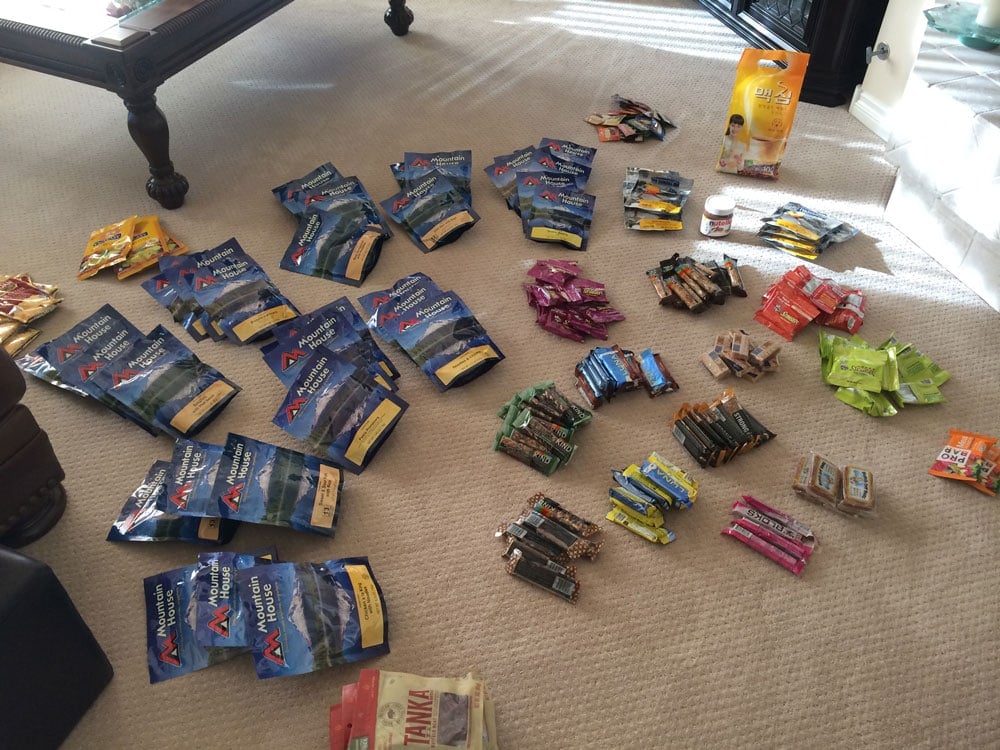
Before packing up your John Muir Trail resupply packages, make sure each food drop will fit into your bear-proof canister, which is required for all sections of the John Muir Trail. If any food doesn’t fit, you’ll need to either eat it on the spot or donate it, which might mean you run low on food later.
Kristen and her hiking partner each carried their own Wild Ideas Weekend Bearikade bear canisters, which are designed to hold enough food for 1 person for 6 days. With some strategizing and repackaging into Ziplocks, it’s usually possible to squeeze 7 days into a bear canister. It’s amazing how much room all of the air takes up in the store-bought packaging! You can rent bear canisters from the park service or some outdoor shops, but if you want to buy your own, check out our post on the Best Bear Canisters for Backpacking.
Also, keep in mind that you can’t ship fuel canisters through the mail. Fortunately, most of the resupply points have fuel available anyway. An efficient stove like the Jetboil Flash will help cut down on fuel needs. Over Kristen’s 22-day hike, she got by with three 8-oz fuel canisters for two people using the Flash.
Finally, you’ll want to include any extra supplies in your packages that you think you’ll need to replenish like blister bandaids, toilet paper, sunscreen, and toothpaste. Also, consider adding a few heavy or bulky treats like canned peaches that you’ll consume right away and discard the packaging. Red’s, Vermillion Valley Resort, and Muir Trail Ranch all accept trash from backpackers.
Step 4: Pack and mail your John Muir Trail food drop
Plastic 5-gallon buckets work well for mailing your resupplies. In fact, Muir Trail Ranch requires that you use critter and rainproof plastic buckets, so it’s easier if you just use buckets for all of your packages. Each of the resupply spots has specific instructions for their process, so it’s best practice to familiarize yourself with their protocols.
For each John Muir Trail food drop, we were able to fit all of the supplies for two people into a single 5-gallon bucket. To mail a plastic bucket, tape the lid and handle down and then use clear tape to attach the address label to the top of the lid.
Muir Trail Ranch resupply recommends mailing your packages three weeks before your arrival, so don’t wait until the very last minute to take care of this or your package might not arrive in time. On that note, since some of the resupply points are hours from a post office, they might only pick up packages once or twice a week. Keep this in mind as you’re preparing your shipments. Earlier is better!
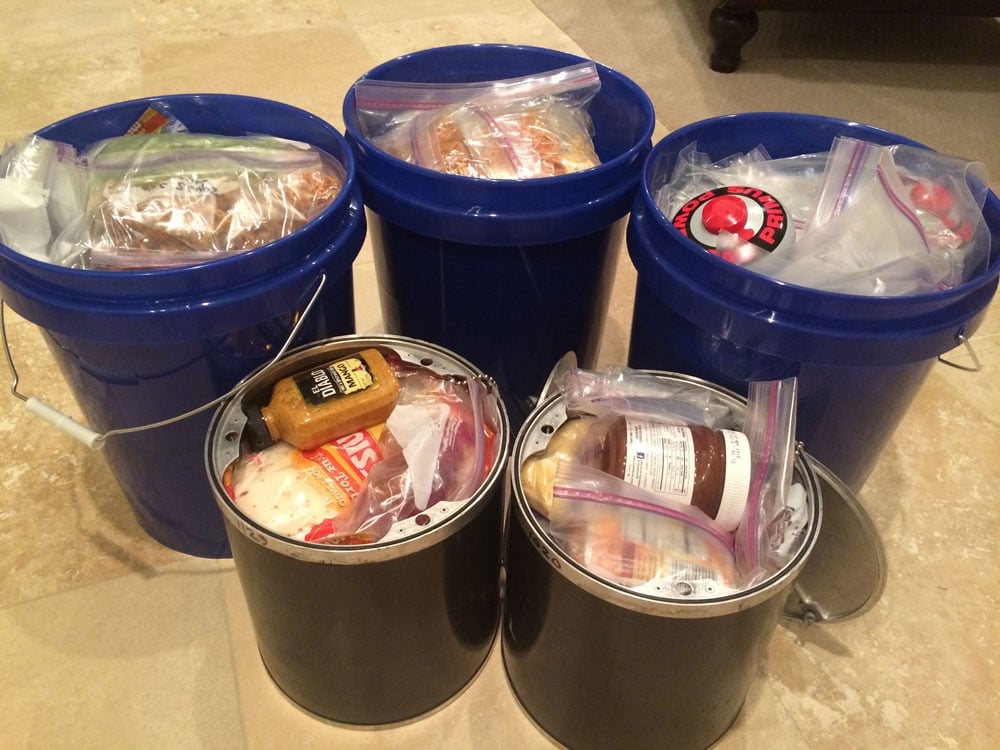
Save this post!
Enter your email & I'll send this post to your inbox! You'll also receive my weekly newsletter full of helpful advice for planning your adventures.
Our Recommended Resupply Strategy for the John Muir Trail
Below you will find charts that can help you visualize how many meals you will need for each section of the JMT. We’ve split up the charts by section based on where Kristen resupplied using her 10 miles per day average pace. If you think you will be hiking at a different pace, simply divide the miles between resupplies by the average pace you plan on hiking. We also include additional John Muir Trail resupply points and show them on the charts so you have a full picture of your JMT resupply options.
Departing Yosemite
- Total miles from Yosemite Valley to first resupply point = 60 miles
- 60 miles / 10 miles per day = 6 DAYS OF FOOD
Assuming an average pace of 10 miles per day, you should be carrying 6 days of food when you leave Yosemite unless you plan on resupplying at the Tuolumne Meadows Post Office. Six days of food will last you until Red’s Meadow at mile 60. For us, a resupply in Tuolumne Meadows didn’t seem necessary because we started at the Sunrise Lakes Trailhead and avoided the steep climb that people face coming up from Yosemite Valley.
For those starting in Yosemite Valley, a resupply at Tuolumne Meadows might be worth considering. If you need to resupply in Tuolumne, here is the USPS general delivery shipping address:
Your Name Here
c\o General Delivery
Tuolumne Meadows Post Office
Yosemite National Park, CA 95389
Arriving by: ETA
Note: As of 2022, the Tuolumne Meadows Campground is closed until 2024 or 2025, and the post office has modified hours. We recommend confirming they will accept resupply packages or plan to skip this resupply spot altogether. The post office number is 209-372-8236.
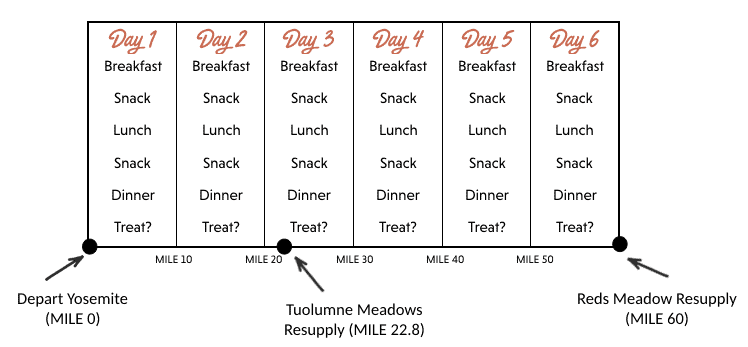
Recommended JMT Resupply Point #1: Red’s Meadow
Red’s Meadow is located near the town of Mammoth Lakes and Devil’s Postpile National Monument. It’s a logical first John Muir Trail resupply point whether you begin your hike in Yosemite Valley or Tuolumne Meadows.
- Total miles between Red’s Meadows and the next resupply point at Muir Trail Ranch = 50 miles
- 50 miles / 10 miles per day = 5 DAYS OF FOOD
The following meals for days 7-11 were included in the resupply box that I sent to Red’s Meadow.

Red’s Meadow Resupply Instructions
Red’s Meadow Resort does not receive mail directly, but they will pick up your package from the post office in Mammoth Lakes and hold it for you at the Red’s Meadow General Store. You can pick your package up any day of the week between the hours of 7am and 7pm. Alternatively, you can hand deliver your package to the Red’s Meadow General Store and they will hold it for $3/day. To ship your package:
- Approximately 2 weeks before you ship your package, print out this form, fill it out, then send it in an envelope with a $40 check, money order, or credit card information to:
- Red’s Meadow Resort
P.O. Box 395
Mammoth Lakes, CA 93546
- Red’s Meadow Resort
- Pack all food in a plastic bucket (5 gallons or smaller)
- Ship it via US Postal Service (USPS) to the following address approximately 2 weeks after you sent your authorization form:
Your Name
Red’s Meadow Resort
P.O. Box 395
Mammoth Lakes, CA 93546
Other things to know about JMT Resupply at Red’s Meadow
- Depending on where you are coming from, it may be convenient for you to drop off your package in person. Red’s Meadow is located just outside Mammoth Lakes. In order to get to Red’s Meadow during summer, you must take the $8 Devil’s Postpile shuttle from the Mammoth ski area to the lodge (no private vehicles are allowed). It’s about a 45-minute ride. If you drop your package off in person, they waive the $40 fee and all you pay is a $3/day holding fee. Plus you save money on postage. I’m not sure the savings are worth the hassle, but I ended up staying the night in Mammoth Lakes on my drive up to the trailhead anyway, so it wasn’t really far out of my way.
- Packages may be picked up between the hours of 7am and 7pm daily.
- Red’s Meadow has hiker cabins available for $70 per night (single) or $120 (double). The price includes 1 shower/person. Space is limited with only 2 cabins, so reservations are recommended.
- There is a general store on-site that sells a small variety of food items, cold beer, and limited camping supplies. There is also a restaurant called the Mule House Cafe that serves breakfast, lunch, and dinner if you want a hot meal.
- Stove fuel is available for sale. If you have concerns about them having your specific type of fuel, you can give them a call.
- The main campground for Red’s Meadow is located just down the hill from the resort on a small side trail. There is a $28 fee to camp at the campground and cash is required. There is plenty of room and reservations aren’t necessary, but it may not be open early in the season. The campground has bear lockers, toilets, and campfire rings. It’s a bit of a shock to have to pay for camping here after camping for free on the trail. However, we stayed at the campground, and it ended up being a fun experience. We met a bunch of other JMT hikers who I am still friends with today and it also allows you to use the bear lockers for the night if your bear bins are too full from your resupply. There is also a natural hot spring in a concrete cistern near the campground.
Red’s Meadow Contact Info
- Website: http://www.redsmeadow.com/
- Phone (760) 934-2345
- Email: info@redsmeadow.com

Optional JMT Resupply Point: Vermilion Valley Resort
Some people break up the section between Red’s Meadow and Muir Trail Ranch with an additional stop at Vermilion Valley Resort (VVR). For Kristen, this was another resupply point that seemed unnecessary, especially since getting there requires quite a few extra miles. However, Mary spontaneously made the detour to VVR on foot and was pleasantly surprised to arrive just in time for BBQ night! Between the hot meal, hot showers, laundry, and meeting other hikers, VVR was worth every extra step.
Early-season hikers might also need to resupply at VVR instead of Muir Trail Ranch, as Muir Trail Ranch typically opens sometime between mid-June and early July, depending on the snow. Be sure to check back in the spring to find out the specific dates they’ll open if you plan to hike earlier in the season. If you are passing through this section of the trail earlier in the season, a stop at VVR may be necessary.
VVR is located on the far edge of Lake Thomas Edison approximately 4.5 miles from the JMT, adding a total of about 10 miles to your trip. They also offer water taxi and shuttle services to and from the trail for a fee. VVR does have free tent camping and other lodging options, a restaurant, a camp store that sells fuel and snacks, and a hiker box of donated food.
Vermilion Valley Resort Resupply Instructions
To mail a package to VVR, pack your resupply in either a sturdy box or a 5-gallon bucket. Either way, it can’t weigh over 25 pounds. Your name and estimated arrival date must be clearly visible on four sides of your package, including the lid. Packages take about two weeks to get to the post office near VVR and then can take another week to get picked up and delivered to the resort on Lake Edison. VVR is usually open for backpackers to pick up resupplies between 7am and 8pm, from Memorial Day and Labor Day. You’ll need to pay the $30 handling fee in person by cash or card at time of pick up.
To ship via USPS send to:
Hold for Hiker (Your Name)
℅ VVR- General Delivery
Lakeshore, CA 93634
To ship via UPS/ FedEx:
Vermilion Valley Resort – Your Name
c/o China Peak Landing
62311 Huntington Lake Rd.
Lakeshore, CA 93634
If you choose to resupply at VVR, visit their website for more details. They have very specific instructions for resupplies and ask hikers to thoroughly read and understand their process.
Other things to know about JMT Resupply at VVR
Vermilion Valley Resort is a remote (but car-accessible) fishing lodge on the southwestern shore of Lake Thomas Edison. The JMT runs on the east side of the lake so to reach the resort you’ll have to hike around the lake or catch a ferry from the dock on the north end, 1.1 miles from the JMT. Ferry hours vary and some years the lake is too low for it to run, in which case you’ll have to hike 5.9 miles along the north shore of the lake or 8 miles along the east side to reach VVR.
- VVR rents hostel beds, tent cabins, hotel rooms, yurts, and tiny homes or thru-hikers camp for free in their campground
- The restaurant is open for three hot meals a day for breakfast from 7:30am to 9am for eggs, pancakes and burritos, Lunch from 12-2 for burgers, tacos, and salads and Dinner from 5:30 to 8pm, serving steaks, pizzas, BBQ, and vegetarian meals.
- The Camp Store is open from 7am to 8pm daily. The store stocks cold drinks, ice cream, fruit, dehydrated meals, hiking and camping gear, stove fuel canisters, wine and firewood. Traditionally, the first cold drink is free for thru-hikers.
- VVR offers hot, coin-operated showers, as well as washer/ dryers, with loaner clothes to wear while you’re washing every article of clothing you have with you.
- For those who want to connect with loved ones or the wider world, there is WiFi
- VVR usually keeps a hiker box, where you can trade in unwanted food and pick up supplementary meals and treats.
Vermilion Valley Resort Contact Info
- To contact VVR, Email is preferred: info@vvr.place or call (559) 259-4000.
- Visit this page for resupply information
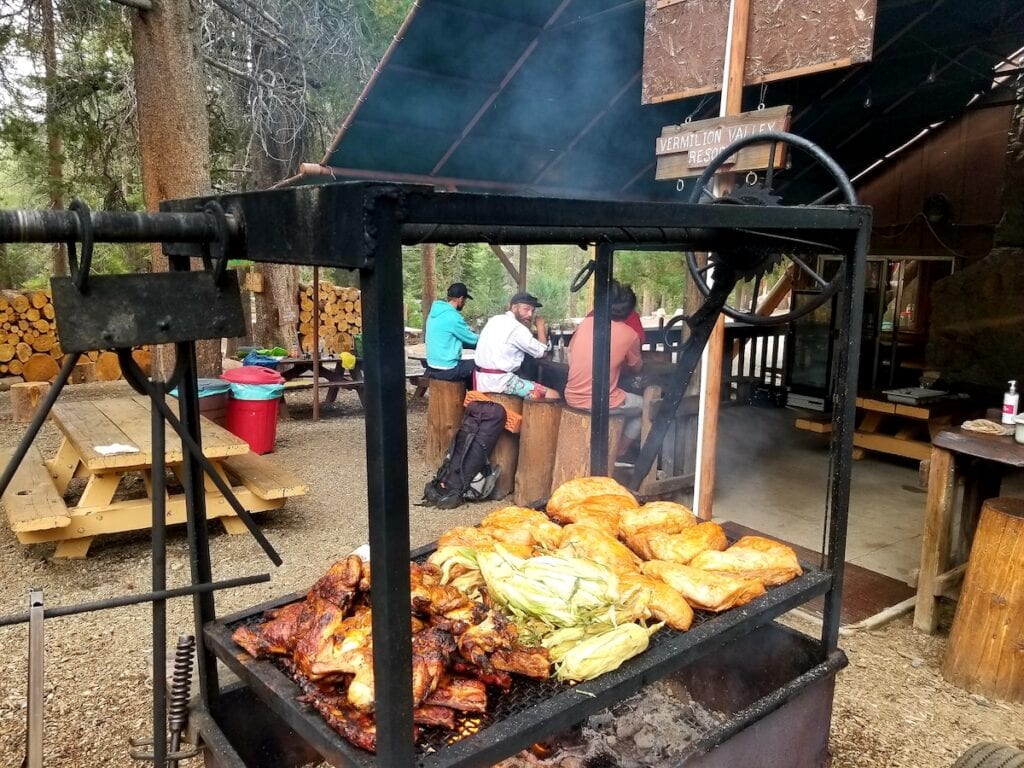
Recommended JMT Resupply Point #2: Muir Trail Ranch
Whether you stop at VVR or not, everyone pretty much stops at Muir Trail Ranch (as long as it’s open). It’s located directly on the trail and it’s the last convenient resupply point on the John Muir Trail if you’re hiking south. In fact, some people hoof it all the way to Whitney without another resupply after stopping at Muir Trail Ranch. For these people, stopping here is necessary.
- Total miles between Muir Trail Ranch and the next resupply at Onion Valley = 70 miles
- 70 miles / 10 miles per day = 7 DAYS OF FOOD + some extra for the hike out to the Onion Valley parking lot
The following meals for days 12-18 were included in the resupply box that I sent to Muir Trail Ranch:
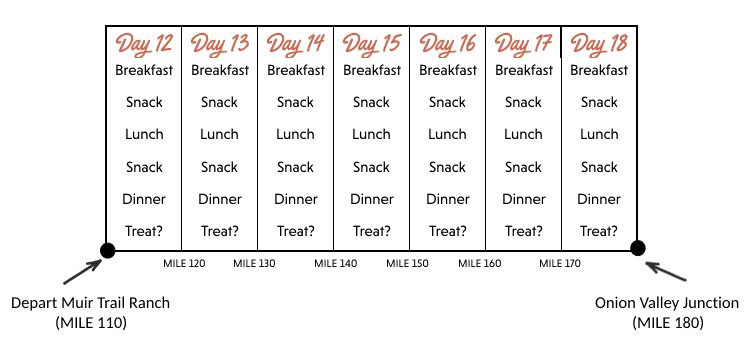
Muir Trail Ranch Resupply Instructions
- Pack all food in a plastic bucket
- Go to this page for instructions to pay the service fee by credit card. Muir Trail Ranch charges $95 for each bucket weighing up to 25 pounds. If you go over 25 pounds, it’s an extra $2 per pound.
- Print the provided shipping label and the identification form you automatically receive when you pay online and tape them to the top of the bucket (not the side!).
- Send your bucket using US Postal Service (USPS) Priority mail with delivery confirmation. Due to the remote nature of Muir Trail Ranch, you must mail your package 3 weeks prior to your expected arrival date.
Other things to know about JMT Resupply at Muir Trail Ranch
- Packages may be picked up between 8am and 5pm daily.
- There is a free JMT thru-hikers campground. It does get busy, and there is not a lot of privacy. However, it’s right on the river and there are a series of hot springs that are nice to soak in just across the river.
- Services are limited at Muir Trail Ranch. Only guests staying in their private cabins have access to the restaurant, bathrooms, and showers. If you are interested in staying in a cabin, reservations are recommended.
- There is a very small store with only a limited selection of camping and first aid supplies, bug spray, and sunscreen (no food or beverages).
Muir Trail Ranch Contact Info
- Email: howdy@muirtrailranch.com
- Visit this page for complete Muir Trail Ranch resupply information.
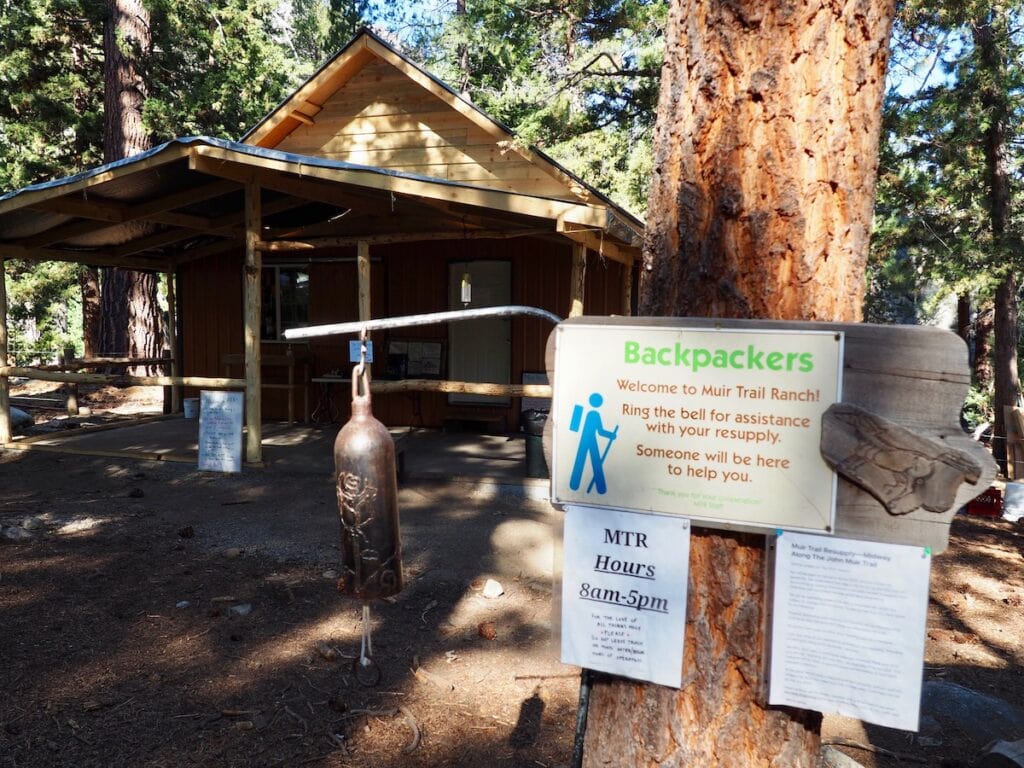
Recommended JMT Resupply Point #3: Onion Valley
Some JMT hikers do not stop at Onion Valley and continue straight through to Mt. Whitney. Those people pack light, hike fast, and have large enough bear canisters to hold up to 9-10 days of food. Both Kristen and Mary resupplied at Onion Valley and would do so again. The 15-mile round trip detour past Bullfrog Lake, Kearsage Lakes, and over Kearsage Pass is beautiful, and adding an extra resupply can help reduce some of your load.
The Onion Valley parking lot is located 7.5 miles off the John Muir Trail which is definitely a factor to consider when planning your meals since you will want a little bit extra food for those extra miles.
- Total miles between Onion Valley and the Whitney Portal = 40
- 40 miles / 10 miles per day = 4 DAYS OF FOOD + one extra day for the hike back to the JMT from Onion Valley
The following meals for days 19-22 plus one additional day were included in the resupply box that I sent to Onion Valley.
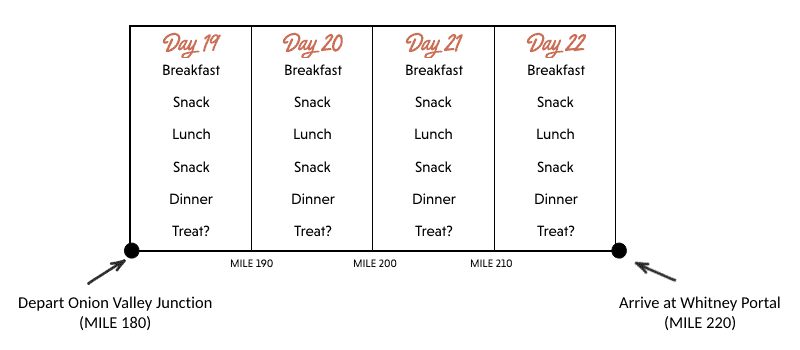
There are a couple of ways to do your John Muir Trail resupply at Onion Valley:
If you have some nice friends who are willing to meet you at the Onion Valley trailhead, that’s ideal. Mary had her dog-sitting friends meet her at the Onion Valley trailhead, but that isn’t an option for most hikers.
That’s where the friendly folks at the Mt. Williamson Motel in Independence come in, offering several options for resupply. First, for $75, the Mt. Williamson Motel will hold packages for non-hotel guests in town. This requires you to get to and from town to pick it up. The next tier up is the full-service resupply package for non-hotel guests for $160. With this option, they’ll hold your package and provide transportation between Onion Valley and the Mt. Williamson Motel in Independence.
Alternatively, if you are looking for a hot meal, shower, and laundry, the Mt. Williamson Motel also offers a complete resupply package where they will provide lodging and roundtrip transportation to and from the Mt. Williamson Motel. The cost for this is $285 (single occupancy) or $385 (double occupancy) and includes transportation, accommodations, hot breakfast, laundry, and storage of your resupply package.
Note: In previous years, the Mt. Williamson Motel would drop off JMT resupply packages at the Onion Valley Trailhead for JMT hikers, which is the service Kristen utilized. However, as of 2016 the Forest Service no longer allows food caches to be stored at the trailhead. They will confiscate them.
Mt. Williamson Motel Onion Valley Resupply Instructions
- Contact the motel to arrange your desired service and pay online here.
- Download the resupply instructions.
- Fill out and mail the forms according to instructions.
- Pack all food in a plastic bucket, tape the labels to the bucket, and send it to the address below. Ensure it arrives at least one week prior to your arrival date.
Mt. Williamson Motel and Base Camp
PO Box 128
Independence, CA 93526-0128
Other things to know about Mt. Williamson Onion Valley resupply
- There are plenty of places to camp along the trail going from the JMT to Onion Valley. Kristen camped at Flower Lake on the east side of Kearsarge Pass and Mary camped at Kearsage Lakes, one of her favorite campsites on the JMT.
- Whether you just want a simple package pick-up or full-blown lodging, the Mt. Williamson Motel gets busy in the summer so make reservations far in advance.
- Most people have cell phone service on the top of Kearsarge Pass and in Onion Valley so if you encounter any problems with your bucket, you can give the motel a call.
Mt. Williamson Motel Contact Info
- Website: http://mtwilliamsonmotel.com/
- Email: Info@mtwilliamsonmotel.com
- Phone: (760) 878-2121

Additional JMT Resupply Options
JMT Resupply via Pack Trains
The Sierra is a horsepacker’s paradise, with many trails, including the JMT, built and maintained for stock travel with horses, mules, donkeys, llamas, and pack goats. One strategy for resupplying without having to leave the trail is to arrange for a packer to meet you in the backcountry. There are many pack stations throughout the Sierra but only a handful cover the JMT. The most common places on the JMT to meet a packer for a resupply are Bishop Pass, Kearsage Pass, and Wood’s Creek.
Other things to know about Pack Train resupply
- You usually pay per mule, which can carry from 90 to 150 pounds, so while expensive, you can split a resupply with several other hikers.
- You can mail the packers your resupply or drop it off at a pack station before your trip.
- Supplies can be picked up at the packer’s stations, which require a side trip or they’ll meet you on the trail.
- Packers cannot leave anything unattended so you’ll have to coordinate meeting them on the trail at a certain time and place, which can be tricky and stressful with minimal cell service.
- Other potential meeting points include Shepherd, Sawmill, Taboose and Italy Passes, as well as Charlotte Lake and Evolution Valley. But Bishop Pass and Kearsage Pass usually make the most sense logistically, if you’re utilizing Red’s Meadow and Muir Trail Ranch.
Sierra Pack Stations Contact Info
- Sequoia Kings Pack Trains in Independence (meet at Kearsage Pass) and Pine Creek Pack Outfit in Bishop (meet at Bishop Pass) are both operated by the same family. Phone: 800-962-0775 or email bernerspack@yahoo.com.
- Rainbow Pack Outfitters in Bishop (can meet at Bishop Pass or Le Conte Ranger Station). Contact: (760) 873-8877 or info@rainbowpackoutfitters.com
- Cedar Grove Pack Station at Road’s End in Kings Canyon National Park can meet at Wood’s Creek. Contact: (559) 565-3464
- Here is a general list of pack outfitters in the Sierra, in case you’re looking for more options.
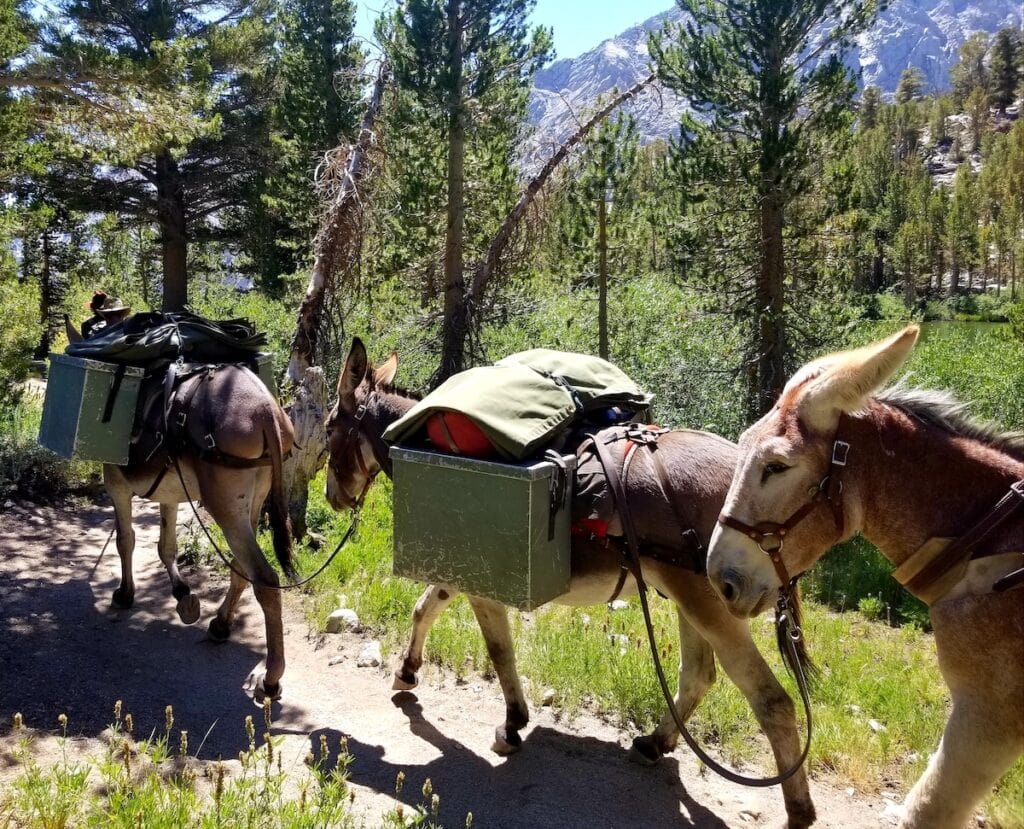
Custom Hired Resupply Services
If figuring out your own resupply is too daunting for you, there are at least two companies that will arrange all your resupplies for you. They will shop for your food, pack your boxes and ship them to Tuolumne Meadow, Red’s Meadow, VVR, MTR, or several different pack stations and post offices along the route. It’s best to give these companies a call to learn more about their services:
- Triple Crown Outfitters in Kennedy Meadows. Phone: (559) 850-4453, email: jackie@triplecrownoutfitters.com
- Zero Day Resupply is based in New Hampshire but they resupply hikers on trails all over the US.
There are many ways to resupply on the John Muir Trail, depending on your pace, fitness, and dietary needs. There is really no right or wrong way to do it, as long as you have enough food for your trip and are able to fit it all in an approved bear canister. Elizabeth Wenk’s paperback guide to the John Muir Trail also has some helpful information about resupply as well as maps. Hopefully, these details give you a better understanding of the resupply process as you customize a plan for your hike.
Related Blog Posts:
- Complete John Muir Trail Planning Guide
- 3 Week John Muir Trail Itinerary
- JMT Trail Food Shopping List
- How to Apply for a Southbound JMT Permit
- JMT Maps, Apps, Books, & Resources
- John Muir Trail Gear List
>> See our entire John Muir Trail archive
If you have any questions about how to resupply for the John Muir Trail or want to share any JMT resupply tips for future thru hikers, leave them in the comments below.


that’s important, i guess most women are good in it 😉
Hi Kristen- I am planning to meet my daughter who is hiking the JMT at onion valley for her resupply. Do I need a permit? Thx Dot
You shouldn’t need a permit if you’re just hiking in for the day
Thank you, Kristen. Excellent article. Great advice. I especially appreciated the mileages include. Hoping to thru hike in 2021.
Thanks for reading Lonnie and we’re glad you found it helpful. Best of luck on your thru-hike in 2021!
Kristen,
Your freakin awesome. Yet another great article that helps so much. You make the educational part of this hike pretty painless… I’ll hold that thought as I’m walking up those passes. Thanks again.
Patrick
PS. Do you like your new Neo-air better than your Pro-lite?
You seem so organized – I like it 🙂
I think it’s fascinating when people do these trails.
I really want to do it as well some day.
Oh, I also find it pretty cool that you collect your food along the way, I had no idea it worked like that. Guess you learn something new every day! 🙂
Zascha – Thanks for the comment! I didn’t really know too much about long distance hiking before my JMT trip. Organization when planning a trip like that is really important though…don’t want to run outta food halfway through. If you decide to do the JMT, let me know! I’d be happy to help answer any other questions you might have. Thanks! Kristen
This is seriously gold….
Ok, so maybe I might’ve looked past it, but have you gone over navigation on the trail yet by any chance? I guess I’m just curious if there are ever times in the trail where one could easily get off-trail…
I do plan on preparing by studying maps and having maps with a compass, but wanted to see what your experiences were like when navigating on the JMT. If you’ve already posted about this, you can just link the article.
Also…when I did the Half Dome last weekend, we were trying to figure out the best method to clean our pots & utencils…especially after making some ramen. We figured out instead of wasting napkins/clothes to wipe down(which just builds up waste), we found that boiling some water in it does a much better job, but you do waste fuel… Any suggestions?
Daniel – Glad you found the post helpful.
I haven’t done a post on navigation yet. The trail is very well marked for the most part. I carried the Tom Harrison maps and the Wenk book. Both are listed in my JMT Gear Guide. I also had a compass on my watch but never needed it. Also didn’t find that a GPS would be necessary.
https://bearfoottheory.com/john-muir-trail-gear-list/
We also found that boiling water was the easiest way to do dishes. Generally we split one backpacking meal per night plus something else like cous cous or ramen. So we would first make the thing that was going to get the pot dirty. Once we ate that, we would boil the water for our backpacking meal. And as the water was boiling, I would slide my spork up and down the sides of the pot to dislodge any stuck food particles. Also brought a bandana to wipe things clean. Not sure what kind of stove you have, but the jetboil is extremely efficient with fuel and with the jetbil boiling a 1/2 cup of water to clean your dishes shouldn’t eat up too much fuel.
The information is great. But when you end at Whitney, how do you get off the trail. I live in Northern MN and I’m looking at a hike next summer. I can figure out how to get to Yosemite but their not much about the end of the JMT. I would guess I would be flying in San Fran and out of there as well. Where can I find information on how to get back to the airport after the hike?
Thanks
Peter
Peter – That’s a great question. I’ve actually been thinking about putting a post together about transportation. We had a car parked at the Whitney portal and a car parked in Yosemite. Although thats probably not an option for most people who are traveling from out of state. I’ll try and gather the info and post it on my blog shortly. Thanks for stopping by and if you have any other questions, let me know. Thanks! Kristen
Peter,
it is easier to get to LAX than SFO at the end of your hike at Whitney. From the Portal, hitch into Lone Pine. Check the Eastern Sierra Transit website for the schedule of the bus that takes you south to Lancaster. From there, you can get the Fly Away shuttle direct to LAX.
For getting to your starting TH in Yosemite, same routine. Get to Lancaster, take EST all the way to Mammoth Lakes for a bit of high altitude training hikes to get acclimated (highly recommended!) Then, catch the Yosemite Area Rapid Transit System (YARTS) bus to either T. Mdws. or to Yosemite Valley. If you arrive by bus into Yosemite, you are allowed 2 nights in the backpackers campground at either T. Mdws. or the one near Happy Isles. $5/pp/pn. Suggest getting the WENK guide NOW to start planning. Good Luck!
Thanks for chiming in Rick!
I’m looking to do the JMT next year. I live in Australia so there’ll be no chance for me to prep and post food to the resupply points as you did as i read it can take a few weeks for the boxes to arrive at the resupply points.
Asside from what i can pack in with me, do you think there is enough variety of dehydrated meals at the stores along the way?
Worst case, would I would possibly have sufficient lead time to pack a box in Fresno and post to Onion Valley?
Thanks 🙂
My suggestion would be to drop-off resupply boxes in person both at Reds Meadow and Onion Valley. Those are both places you can drive to pretty easily.
I hear you can buy some stuff at VVR, but I didn’t go there, so I can’t say for sure what they have on hand. Then there is really nothing for sale at Muir Trail Ranch. So your biggest challenge will be getting from Reds Meadow to Onion Valley, which is a long stretch…about 110 miles. If you hike fast, you could probably do this section in a week. Remember you also need to put everything in a bear bin, and most bins don’t really hold more than 7 days worth of food.
Do you know anyone in the states that would be willing to send a package in advance to Muir Trail Ranch for you? If so, that would be the best way to go.
Good luck and let me know what you decide to do!
Hello,
Are you required to put ALL of our resupply food in our bear canister.
Can’t we just carry some for on the trail that day?
Hey Carlin – So technically you are supposed to put all of your food in your canister. But like you suggest, we ended up taking our lunch and snacks out every morning to avoid having to take the whole canister out every time we got hungry. If you do have any food out in your pack, just make sure you don’t leave your bag unattended. Lots of marmots and little animals that can chew right through your pack.
Thanks for such complete information. It seems that you did not take any zero days, is that right? Would you do it that way again? If we do take zero days, your calculations don’t include that correct? So, when planning food with one or two zero days, would we be able to get food at the resupply points and not use our backpacking food? Seems like a couple of places this is possible.
Once again, thanks for laying this out so thoroughly..
Hey Cindy – Yep that’s right. We didn’t take any zero days. Reds Meadows and VVR both have food available, but Muir Trail Ranch and Onion Valley do not. You can also take a bus from Reds Meadow into Mammoth. So if you are going to take a zero day, those first two resupply spots would be the best if you don’t want to carry extra food. Hope thats helpful and if you have any other questions, let me know. Thanks! Kristen
You saved all of us future JMT hikers a ton of time searching this info out! Your website is quite thorough and very helpful. Thanks!!! Can’t wait to get my trail trance on this summer doing the JMT!
Hey Randy! Thanks so much! The JMT was so awesome, and I’m glad to be of help. You gotta come back and let me know how your planning is going and also if any questions pop up. Thanks and happy trails! Kristen
Thank you Kristen,
This makes my planning stage far less confusing than it could’ve been. Well done.
Thanks Alexander. I’m glad it was helpful!
Hey Kristen,
Thank you so much for taking the time to write this blog with so much helpful information and to answer questions as well. I’ve been wanting to do the JMT since I was about 12 year old and I’m hoping to finally hike it with a friend the summer after next. (Next summer is already overbooked).
I had a few questions for you:
Where did you keep the Jetboil after using it for cooking? Did you have any problems with bears?
Are there places that don’t charge a small fortune for supply drops? Were you able to drop of your trash for the week there?
Were there any places to recharge camera batteries along your route (using a regular AC plug)?
How many times could you boil water at altitude with your 230g fuel container?
I’m primarily a hammock backpacker; were there plenty of places to along the route to hang a hammock or would I need a sleeping pad?
Jeremy
Hey Jeremy –
First off, the 2016 permit process is just about to start, so it definitely isn’t booked yet. To answer your questions.
1) I mostly used the jetboil for boiling water, so I just kept it with the rest of my stuff. It probably wouldn’t be a bad idea to store it near your bear canister at night away from your tent. We didn’t have any problems with bears. the only place i heard about them being a nucance was near Little Yosemite valley at the very beginning.
2) No there is no where you can charge stuff along the trail. Bring extra batteries and a solar panel if you think you will need to charge. Have you seen my gear list?
3) One of the medium fuel canisters lasted us about 5 or soi days for two people using twice a day – coffee/oatmeal for breakfast and boiling water for dinner.
4) You definitely will want a sleeping pad. There are lots of places where you are above the tree line and will have no where to hang a hammock. And even in your hammock, a sleeping pad will provide extra insulation for those very cold nights.
Hope that’s helpful!
Kristen
Hey Kisten,
Thanks for all the good info. Getting a permit was pretty difficult but after two weeks of rejection we finally got approved. Question, is there any cell service along the trail?
Congrats! The only places I got cell service were at Reds meadow and at the top of Kearsarge Pass.
I’m looking to go later in the season. Any idea on closing dates for Reds Meadow and MTR? I want to make sure I can pick up my supplies?
I think they close in mid-September, but both are closed now for the season, so we’ll have to wait to see what they say when they open for 2016. Dates may be different than last year.
This blog is awesome; Thanks for all the great advice!
Random question – What do you do with your plastic 5-gallon bucket after you take all the contents out of it?
I imagine these places rack up a large number of buckets, but I was just curious if there is a system in place for them to remove/reuse/dispose once you are done with them. Do you just leave them there and they will take care of it?
Steve – Yes, Reds Meadow and MTR both take buckets and recycle, reuse them.
Kristen,~ I\\\’m doing the JMT mid June. I will be starting at Sunrise Lake and spending the first night at Lower Cathedral Lake, is there a shuttle that will take me to the trailhead?
Love your blog, I\\\’ve been using it to plan my trip! Thank you!
Hey Tami – Yep! There is a shuttle that leaves from the Tuolumne Meadows Rangers Station that is free. Have fun and stoked it’s been helpful!
How do you get to Sunrise Lake? This is where I will be starting from.
There is a free shuttle from the Tuolumne Meadows Ranger station.
Hi Kristen,
I can not thank you enough for all the great information and resources you have provided. I do have one question regarding the permit process. Where was it or who suggested the 12:01am-7:30am time frame for priority consideration? I spoke with a couple of Rangers, and they would not confirm this. They suggested that it did not make a difference. I have been faxing my permit at all hours ranging from 12:01-3am-7am. So far, I’ve been denided 7 days in a row. I’m am eager to do whatever it takes in order to secure a permit. Any advice or additional information is much appreciated.
The time you submit your fax doesn’t make a difference as long as it’s in before 7:30 am. My fingers are crossed for ya!
Hi Kristen!
Thanks for all of your detailed information about planning and hiking the JMT. Your eloquent posts and beautiful photos have definitely inspired my husband and me to do the trail this coming summer. We were denied permits from Yosemite for the 2+ week window we had to start our trek, so we have decided to hike from south to north instead. We have reserved a permit from Cottonwood Pass, a few days south of Mt. Whitney, and will be starting from there. We will definitely resupply at Onion Valley, but I have read that you are not allowed to leave caches unattended at all and that rangers will confiscate your food if they find them. I was curious how you arranged with the Mt. Williamson Hotel. Do the rangers know Strider and leave her drops alone? Or did you time your arrival there to meet her in person? We are not quite sure how starting at Cottonwood Pass is going to affect our resupply strategy yet. We are not sure if adding 3 days on to the beginning of the trek will mean that we need to resupply before leaving Mt. Whitney. Any suggestions for that? Also, I read in one of your comments that none of the other resupply points (Muir Trail Ranch and Reds Meadow) give you the option to charge batteries. Is that really true? How many camera batteries did you use on the trail? Thanks in advance for your advice!
Hi Alison – You are going to have the best time. As far as the Mount Williamson motel, I would call and talk with Strider and she what she says about the Onion Valley resupply. I have a hard time imagining rangers taking people’s food, but maybe things have changed since I hiked it.
I don’t think you’ll want to need at Whitney, and I’m not sure where you would even do that. It’s only about 3 days between Whitney and Onion Valley, so as long as you start with a weeks worth of food, I think you should be good.
For your camera batteries, yeah there really isn’t anywhere to charge stuff. Maybe if you eat at the restaurant at Reds Meadow you could charge there. I’d suggest bringing a small solar panel to charge your electronics. Check out my gear list from the hike if you need recommendations.
As long as you are picking up a resupply bucket at MTR, you can also charge up your electronics. Was there this past September and saw it done numerous times.
That’s great to hear, thanks for the update.
I have heard that if you resupply at Onion Valley you need to put your name and puck up date on your cache. The Rangers occasionally clean out the storage bins for crap people leave behind. Good luck. Maybe I’ll see you on the journey. I’m on the same route starting Aug 20.
Thanks for chiming in!
I got my permit from Lyell Canyon for the end of August and I can’t wait. I used your website for the whole process. It was ironic that I got an email from amazon suggesting I purchase the JMT maps and sure enough I got my confirmation email that same day!!! It was nice to get the confirmation email instead of the we’re sorry email I received several times.
hey Shane! That’s awesome. So stoked for you and you’ll have to come back and let me know how your trip goes!
Kristen,
Did cooking the freeze dried meals in freezer bags affect the re-hydration at all? When did you transfer the meals to the bags and do you know how long they last once after being opened? Do you know if the fuel has to be kept in the bear canister as well? I usually throw it in my bear bag just in case but there’s a lot more room in the bags.
Love your blog btw! Keep up the good work!!!
Canisters do not have to be stored in the bear bin. Freeze dried meals will last long enough for you to do the hike. I wouldn’t eat them months afterwards, but a month or so they should be fine. Have fun out there!
Thanks for all the great info! Is the only way to reach Berner’s through email? I couldn’t find a website. Also, any idea how easy the JMT walk up permit is at Inyo visitors’ center in Lone Pine? Hitting the trail this August!
Hey Maria – I don’t have any other contact info for the Berners. Sorry about that! And I’m also not sure about a walk up permit in lone pine. If you get any info though, please come back and share it!
Is there anything you wish you would have sent yourself in the resupply buckets that you might of forgotten or didn’t think was important then realized you needed it? Hiking the JMT June 18 and your blog is seriously saving my life at moment!
Miguel,
I\’m hoping to do the hike at the same time next year. Could you share about the weather, mosquitoes, and any snow you encounter when you come back?
I am leaving in 14 Days! I am excited and a little panicky.
What did you do for lunches? I cant get past meal bars, cliff bars, etc…
I was thinking tortillas ans tuna just by looking at your buckets.
also, I see you have fuel in the buckets… did you send some anyway?
Hi, My boyfriend and I are thru hiking northbound on the JMT and I was thinking of renting the Expedition bear canister from Bearikade which states roughly it will hold 12 days of food for a solo hiker. From your experience, is it better to have two bear canisters for two people, or does one large work out ok? My main concern is the 110 miles from Whitney to JM Ranch.
I think its better to have 2 to help distribute the weight of the food between the both of you.
I am going Northbound and trying to plan the resupply with the least amount of stops or time off the trail. We are starting at Crabtree Meadows, so we have two days before Whitney and then possibly 8 days to Reds Meadows to resupply? Any suggestions on resupply as it seems the three close resupply locations are all approx 3 days apart and that would not really buy us much time. I don’t want to send a three day resupply bucket but I am finding it hard to fit 10 days of food in my BV-500.
Really the only options that are pretty close to the trail between Whitney and Reds are VVR & Muir Trail Ranch. Have you looked into these?
Hey Kristen!!!
Great blog, it has answered many JMT questions that I have.
I plan to be on the JMT this time next year in 2017!!! (permit gods willing that is)
I do have a permit question for you. Does each permit application cost you $10 or do they charge you only if a permit is granted?
$10 isn’t much, but if they charge you $10 for each permit application and it takes 3 weeks to land a permit, it can add up fast.
For confirmed reservations only there is a processing fee of $5.00 per permit plus a $5.00 per person reservation fee. So you only get charged if you are successful.
Thank you for all the great information, we are planning a 2017 JMT hike. Do you have any information on the difficulty of getting a walk up permit from Tuolumne? I am hoping if we cannot secure a permit by faxing, we would be able to get in line early and secure one of the “10”.
I’m not sure how that process went this year. I’d call the ranger station in Tuolumne and inquire. Good luck!
Starting at Cottonwood Pass, would I be able to carry extra food each day outside my BV 500, and just store the extra food each night in bear boxes located along the trail?
I’m not sure about the area around Cottonwood Pass. If there are bear bins available, it sounds like your plan would work, but you’d want to be sure about their location before starting your hike. You’d also not be able to leave your pack unattended during the day
Would you happen to know if the resupply locations where you pick up your buckets also have a means to ship out a box or bucket ? I was thinking I would like to ship home extra stuff especially if we do the climb up half dome using a harness, we would like to send those home rather than carry them the entire trip. I was thinking of having a self addressed and stamped label for either a box or bucket to send home….
I love your wealth of information, resupply is such a mystery and it is great to have all the information succinctly documented, thank you !
You can ship stuff out at the post office in Tuolumne Meadows. I’m not sure about the others. You probably can, but I assume it’s expensive. If you are doing Half Dome the normal way up the cables, you don’t need a climbing harness.
Harness is not really needed. Every 10 feet or so are wooden slats that you can stand straight up on to rest. I would encourage you to strengthen your arms and hands by doing pull-ups. If you can’t do a pull-up stand on a chair then pull your chin up above the bar and hang for as long as you can. repeat. Even if you only do this half a dozen times before you climb HalfDome you’ll appreciate having done it. The cables will fatigue your arms and grips if you are not a workout fanatic… good luck and enjoy the view. It’s amazing!
Great article. Resupplies are the most stressful part of planning this trip. This helps bunches! Hiking JMT June 30 – July 20, 2017.
You\’ve got a great guide which answers much of the concerns around resupply along the track. One hurdle was determining how far I\’d walk each day, but a 10mi (roughly 20kms) average seems like a good estimate for me. As a non-U.S. resident living overseas organising for this trip seems like a logistical nightmare. I would like to do JMT in August 2017 but preparing the resupply drops is confusing. I\’ve considered arriving at Mammoth Lakes a week before I set off from Happy Isles trail head, using the week to buy food supplies and organize packing, preparing and mailing them to the corresponding addresses ( Reds and Ranch)…would this work, as you\’ve mentioned they recommend sending supplies 3weeks before you set off. Love to get your feedback on how an overseas visitor might accomplish this. Thanks for your time.
If you arrive a week early and ship your food to Muir Trail Ranch immediately, that should give you 3 weeks, since MTR is about 2 weeks in.
You can drop your supplies off directly at Reds Meadow since it’s right next to Mammoth. As for Onion Valley, I’m not sure what people are doing this year since they’ve said they aren’t’ allowing people to leave food in the bins in the parking lot. But with an extra week, if you drove to Independence and chatted with some people you could figure it out.
Hi Kristen,
I am organising my JMT hike from Australia and have a question regarding the re-supply at Muir Trail Ranch. Do you think I would be able to fit food for two people into one bucket? It would be the final re-supply for my sister and I. It is difficult to figure these things out without actually having all of the food in front of you!
Yes I fit food for two people in each of my resupply buckets.
Hi Kristen,
The reds Meadow resupply form link is not up to date, the price is $40 now.
Tony
Thanks Tony for keeping up with us!
Kristen, Did you pack fuel in your bucket? I’d like to ship the correct amount instead of relying on the sizes that may or may not be available at Reds and MTR.
Hey Don, you are not supposed to pack fuel in your buckets. Keep in mind that you can often pick up half-empty canisters from the hiker box at some locations.
Thank you Kristen! You’ve created an amazing resource!!
On the topic of bear canisters: Is this a requirement? Do they inspect if you have one at any time? Does anyone know someone who actually did get in trouble with rangers for not using a canister?
Hi Greg! Kim, here. I work with Kristen and hiked the Pacific Crest Trail in 2016. Bear canisters are a requirement and it is important you follow the rules to keep yourself safe as well as wildlife. I knew 2 people who got tickets for not having a bear canister on the JMT section of the PCT, it is a pretty hefty fine.
As always great info. You have a nice energy about you.
I see above that you planned the Onion Vally resupply. However I believe I read somewhere else in your blog that you ended up Hiker faster later in your days on the trail. Did this or would this effect your decision to resupply at Onion valley? As in maybe you could have gotten away with just 8 or 9 days resupply at Muir Ranch? Thanks
Kristen, found your article helpful. My question: Did you repackage your food before you sent it in the bucket or once you picked up your resupply on the trail? I wonder because some of the freeze dried food is recommended to be used within a few weeks of opening and since it’s being sent at least 3 weeks before you’ll eat it…I’m concerned repackaging it might not be a good idea until you are ready to put in your backpack. Thanks
Hi there Kenn! Kim here and I can’t speak for Kristen but I hiked the Pacific Crest Trail (you can find my PCT resupply guide on Bearfoot Theory) and I DID repackage freeze-dried food and it was just fine. I bought the large #10 cans of Mountain House to financially make my resupply more financially reasonable and repackaged everything into individual servings. Feel free to reach me @ kim@bearfoottheory.com if you have any additional questions.
Kristen,
I noticed in one of your photos that you packed your fuel canisters in your 5-gallon bucket. Did you do this because you were concerned that the resupply locations wouldn’t have fuel available for sale when you arrived?
I put a fuel canister in the bucket that I dropped off in person, not the one I mailed. I wasn’t sure if there would be fuel available, since we hiked in September.
Reading this makes the JMT actually sound doable! LOL I was looking at section hiking this area of the PCT/JMT and wondering how the heck people go 110mi between resupply stops. Interestingly the Halfmile maps make this sound way harder than your blog post 🙂
JMT section, here I come!
Had a rough experience with Sequoia Kings Pack Trains; we were first limited with scheduling when we could pick up the resupply and raced to get there in time only to find that our resupply was not there. The packer was there with another group’s supply but not ours. We received several excuses from Danica (one of the owners who we corresponded directly with to confirm the pick up) after the fact for why our resupply was not there. We also heard several stories of issues with Sequoia Kings Pack Trains. Suggest using Mt Williamson Hotel for resupply to this area. This could have been an incredibly dangerous situation as we would not have had enough food to even hike out, but thanks to the kindness of strangers and the packer hunting down our box, we were able to get to our resupply 2 days later to finish the trail. Be wary of Sequoia Kings Pack Trains or at least have some back up plans in case the resupply does not show up. Happy trails!
Thanks, Sri for sharing your experience. Happy trails to you as well!
Might be a silly question, but what do you do with your buckets after you have resupplied?
Hi, Alison!
That’s a great question actually. The resupply locations will recycle your bucket for you. Happy Trails!
– Mary Kathryn
Thank you for this awesome article. I have often wondered exactly what to take on a long mission of a hike like that!
Glad you found it helpful!
Hello, I would like clarification on something. Under “Recommended JMT Resupply Point #3: Onion Valley” you wrote “The following meals for days 19-22 plus one additional day were included in the resupply box that I sent to Muir Trail Ranch.” Do you mean “Onion Valley” instead?
Also, is all of the info in here correct still? Any updates or changes? Thanks
Thank for the nice writing. I found a minor type error: “The following meals for days 19-22 plus one additional day were included in the resupply box that I sent to Muir Trail Ranch.” it should sent to “Onion Valley”, not “to Muir Trail Ranch” again!
Thanks for catching that!
How well did the tortillas hold up over 3 weeks ( or the ones in the resupply )? Any mold?
Small flour tortillas tend to hold up the best. We haven’t had issues with mold, but be sure to pack them in a dry airtight baggie.
Hopefully, doing the JMT (8/12 start, but worried about fires). Flying in from SE Virginia. My question is how to prepare my pack and trekking poles so they make it through baggage handling, etc.
Any advice is appreciated.
Hi Bill, I don’t believe trekking poles can be taken as carry-on luggage. They must be checked luggage. I recommend wrapping the tips in plastic if they don’t have caps. Most airlines will also have large plastic bags to put your pack in so that all the straps stay contained.